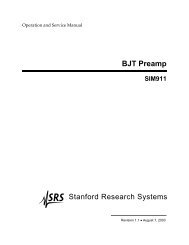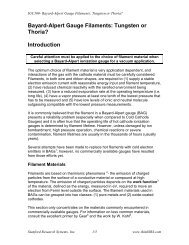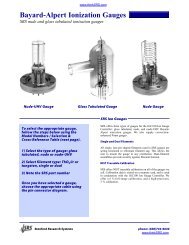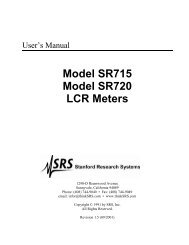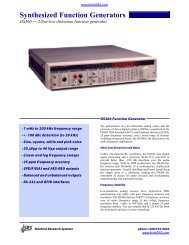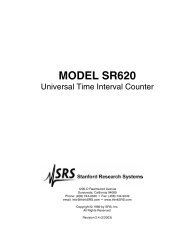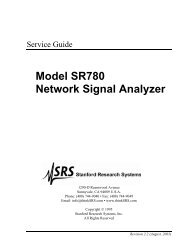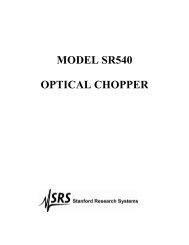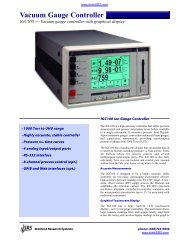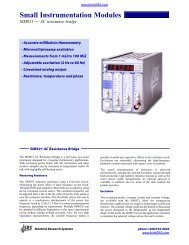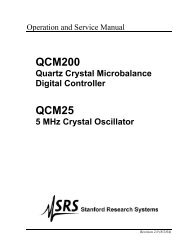Hot vs. Cold Ionization Gauges: Which One is Best for Me?
Hot vs. Cold Ionization Gauges: Which One is Best for Me?
Hot vs. Cold Ionization Gauges: Which One is Best for Me?
Create successful ePaper yourself
Turn your PDF publications into a flip-book with our unique Google optimized e-Paper software.
1<strong>Hot</strong> <strong>vs</strong>. <strong>Cold</strong> <strong>Ionization</strong> <strong>Gauges</strong>Every modern high vacuum and ultrahigh vacuum system relies on some <strong>for</strong>m of ionization gauge <strong>for</strong>pressure measurements under 10 -3 Torr. There are currently two competing ionization gauge technologiesto choose from - the hot cathode gauge (HCG) and the cold cathode gauge (CCG). Th<strong>is</strong> application note<strong>is</strong> designed to help vacuum users choose between the two competing ionization technologies. Each gaugetype has its own advantages and d<strong>is</strong>advantages. The best choice requires careful consideration of theoperating character<strong>is</strong>tics of both gauges and <strong>is</strong> dependent on the application.In Th<strong>is</strong> Application NoteIntroduction 3<strong>Hot</strong>-Cathode <strong>Gauges</strong> (HCG) 4<strong>Cold</strong>-Cathode <strong>Gauges</strong> (CCG) 6Conclusions 8IGC100 Ion Gauge Controller
Mark your calendars <strong>for</strong> these upcoming events in 2013<strong>Me</strong>d<strong>for</strong>d Area Quilt Show March 16 & 17<strong>Me</strong>d<strong>for</strong>d Senior High School1015 W. Broadway Ave.,<strong>Me</strong>d<strong>for</strong>d, WIHere’s to Hollywood Quilt Show April 6 & 7Presented by the Crazy Quilters’ GuildParkview Middle School930 N. RochesterMukwonago, WIQuilter’s Marathon Shop Hop April 25 – May 4.Special events and sales at 30 participating shops. Around the Block Quilt Shop will again beparticipating th<strong>is</strong> year. Additional in<strong>for</strong>mation <strong>is</strong> available at the shop.Scrappy Sensations Quilt Show May 4 & 5Presented by It’s A Stitch Quilt GuildKettle Moraine Lutheran High School3399 Div<strong>is</strong>ion Road – County GJackson, WI 53037V<strong>is</strong>it www.itsastitchquiltguild.com <strong>for</strong> more in<strong>for</strong>mationQuilts in the Garden Quilt Show May 4 & 5Presented by Helping Hands Quilt ClubPhillips High SchoolPhillips, WIUniversity Days May 17 & 18Presented by the W<strong>is</strong>consin Museum of Quilts & Fiber Arts. For in<strong>for</strong>mation v<strong>is</strong>it the website atwww.wiquiltmuseum.comState of W<strong>is</strong>consin Shop Hop. June 7-29. More in<strong>for</strong>mation to follow.Ladies of the Lake Quilt Show August 2 & 3The Ladies of the Lake Quilt Guild would like to encourage quilters of all ages to participate in th<strong>is</strong> year’sshow. Has your daughter, son, granddaughter or grandson sewn something recently? It would be greatto see th<strong>is</strong> area of the exhibit grow. Watch <strong>for</strong> additional in<strong>for</strong>mation on the quilt show as it becomesavailable.
<strong>Hot</strong> <strong>vs</strong>. <strong>Cold</strong> <strong>Ionization</strong> <strong>Gauges</strong>3IntroductionEvery modern high vacuum and ultrahigh vacuum system relies on some <strong>for</strong>m ofionization gauge <strong>for</strong> pressure measurements under 10 -3 Torr. There are currently twocompeting ionization gauge technologies to choose from which are viable means <strong>for</strong>pressure measurements between 10 -2 and 10 -10 Torr:1. In the hot cathode gauge (HCG) ionizing electrons from a thermionic cathode areaccelerated by suitable electrodes into an ionizing space.2. In the cold cathode gauge (CCG) ionization <strong>is</strong> caused by a circulating electronplasma trapped in crossed electric and magnetic fields.In both cases, the electrical current resulting from the collection of the positive ionscreated inside the gauge <strong>is</strong> used as an indirect measure of gas density and pressure.Th<strong>is</strong> application note <strong>is</strong> designed to help vacuum users choose between the twocompeting ionization technologies. Each gauge type has its own advantages andd<strong>is</strong>advantages. The best choice requires careful consideration of the operatingcharacter<strong>is</strong>tics of both gauges and <strong>is</strong> dependent on the application.For more detailed in<strong>for</strong>mation on th<strong>is</strong> subject consult the following publications:1. J. M. Lafferty, Ed., "Foundations of Vacuum Science and Technology", p. 414,section 6.9., John Wiley and Sons, NY, 1998. Note: Th<strong>is</strong> <strong>is</strong> an excellent bookrecommended <strong>for</strong> any high vacuum question.2. R. N. Peacock, N. T. Preacock, and D. S. Hauschulz, "Compar<strong>is</strong>on of hot cathodeand cold cathode ionization gauges", J. Vac. Sci. Technol. A 9(3) (1991) 1977.3. R. F. Kendall, "<strong>Cold</strong> cathode gauges <strong>for</strong> ultrahigh vacuum measurements", J. Vac.Sci. Technol. A 15(3) (1997) 740.4. R. F. Kendall, "<strong>Ionization</strong> Gauge Errors at Low Pressures", J. Vac. Sci. Technol. A17(4) (1999) 2041. Note: Great paper that compares the per<strong>for</strong>mance of both gauges,particularly at low pressures.5. Vic. Comello, "Should your next ion gauge run hot or cold?", R&D Magazine, p. 65,Nov. 1997.6. Eric Bopp, "Pressure measurement in ion implanters", Solid State Technology,February 2000, p. 51. Note: The special gauging requirements of ion implantapplications are nicely d<strong>is</strong>cussed in th<strong>is</strong> article.7. J. H. Singleton, "Practical Guide to the use of Bayard-Alpert <strong>Ionization</strong> <strong>Gauges</strong>",J. Vac. Sci. Technol. A 19(4) (2001) 1712.IGC100 Ion Gauge Controller
4<strong>Hot</strong> <strong>vs</strong>. <strong>Cold</strong> <strong>Ionization</strong> <strong>Gauges</strong><strong>Hot</strong>-Cathode <strong>Gauges</strong> (HCG)The majority of commercially available HCGs are of the Bayard-Alpert design and arecompatible with the IGC100 controller.A Bayard-Alpert gauge (BAG) boils electrons from a hot filament and accelerates themtoward a cylindrical grid cage. As the electrons traverse the space enclosed by the grid,which <strong>is</strong> fully open to the vacuum chamber, they collide with gas molecules ionizingsome of them. A fine wire located at the center of the ionization volume collects theresulting cations producing a current proportional to the gas density at the gauge. Atconstant temperature, the collector current <strong>is</strong> linearly related to the gas pressure.The useful operating range of a conventional BAG extends between 10 -3 and 10 -10 Torr,corresponding to an impressive seven decades of dynamic range. Special gauge designsare available to extend the lower limit to 10 -11 Torr <strong>for</strong> UHV applications, or the upperend to 10 -1 Torr <strong>for</strong> process applications.The strict linear dependence of collector current on pressure <strong>is</strong> one of the most importantadvantages of HCGs over the competing ionization technology. It <strong>is</strong> generally possible toapproximate the 'collector current <strong>vs</strong>. pressure' response of a BAG to a straight line andcalculate pressures from a single linear proportionality factor (i.e. sensitivity factor)stored in the gauge controller. A sensitivity factor calibrated at mid-range, can be used <strong>for</strong>accurate and reproducible pressure measurements between 10 -9 and 10 -4 Torr. Deviationsfrom linearity typically amount to less than ±25% over the entire useful dynamic range ofthe gauge, with the biggest deviations taking place at the operating limits.BAGs are generally considered to be more accurate, stable and reproducible than CCGs.Under controlled vacuum conditions, the reproducibility of a BAG calibration can be asgood as 2% through a year of uninterrupted operation. Repeatability <strong>is</strong> 1-2%, limited byuncontrollable random sensitivity variations. However, not all BAGs are created equaland gauge-to-gauge and long-term stability variations are to be expected fromcommercial devices used in 'real' systems. <strong>Me</strong>asurement accuracies better than ±50%require calibration of the individual gauge response. High accuracy gauge designs haverecently become available that guarantee better than 3% measurement accuracy followingcalibration against NIST standards. Calibrated, high-accuracy BAGs combined with highquality controllers, such as the IGC100, are commonly used as transfer standards in highvacuum gauge calibration laboratories.BAG readings are gas dependent due to varying ionization efficiencies, and are usuallycalibrated <strong>for</strong> nitrogen gas (argon <strong>is</strong> also a popular choice in semiconductor processing).Gas correction factors, readily available from the vacuum literature, can be used tocorrect the gauge readings <strong>for</strong> other gases.Any BAG, depending on its past h<strong>is</strong>tory of operation and the prec<strong>is</strong>e atmosphere in thevacuum system, can act as either a source (outgassing) or sink (pumping) of gas. Itsoperation can cause significant changes to the gas composition in the system. The relativeimportance of these effects depends upon the overall vacuum system character<strong>is</strong>tics andoperating conditions. For example, changes in pressure and gas composition due topumping or outgassing will be relatively more significant in a small UHV system withlow pumping speed, than in a large industrial vacuum chamber with large diffusionIGC100 Ion Gauge Controller
<strong>Hot</strong> <strong>vs</strong>. <strong>Cold</strong> <strong>Ionization</strong> <strong>Gauges</strong>5pumps. Similarly, any pressure gradient between the gauge and the main chamber willdepend upon the conductance of the tube connecting the two, and will be zero when thegauge <strong>is</strong> inserted directly into the chamber (i.e. nude BAG).The power requirement of a typical filament <strong>for</strong> 1 mA em<strong>is</strong>sion <strong>is</strong> between 10 and 15 W.Th<strong>is</strong> <strong>is</strong> enough to cause thermal degassing from the gauge elements and surroundings thataffect the reliability of low pressure measurements. It <strong>is</strong> possible <strong>for</strong> gas composition andpressure in even a large vacuum system to be dominated by gases released from a singleHCG and its immediate surroundings when such a gauge <strong>is</strong> not properly degassed.HCGs encounter most of their problems at ≈10 -10 Torr where the X-ray limit, electronstimulated desorption (ESD) and outgassing set a limit on the usefulness of the gauge.Degassing and bakeout of the gauge can minimize the effects of ESD and outgassing.The ultimate accuracy of a BAG may be seriously comprom<strong>is</strong>ed in the absence of abakeout and/or degassing. The X-ray limit provides a residual collector currentcomparable to the ion signal from 10 -10 Torr of gas in conventional gauges. Special nudegauge designs, with reduced collector and grid wire diameters and closed-end grids, arerequired to reduce the magnitude of that residual current into the 10 -11 Torr level.Reactions of the gas molecules with the hot filament can seriously affect the compositionof the gas, and the reliability of the pressure measurements, in a BAG. Th<strong>is</strong> effect mustalso be accounted <strong>for</strong> in high accuracy measurements at low pressures.Gas permeation through the glass envelope, particularly of He and other light gases, mustbe considered in UHV systems at base pressure, and provides another good reason to useall-metal gauges in those applications.The operating life of a HCG <strong>is</strong> frequently determined by the filament lifetime. Th<strong>is</strong> <strong>is</strong>, byfar, the main reason why high vacuum users choose 'filament-free' <strong>Cold</strong>-Cathode <strong>Gauges</strong>(CCGs) over BAGs. However, unless damaged by ion bombardment, high pressureoperation or chemical effects, filament lifetimes can be many thousands of hours, thusfilament life <strong>is</strong> not an important consideration in most cases. Th<strong>is</strong> <strong>is</strong> especially true withThO 2 Ir filaments and when smart controllers, such as the IGC100, which protect thegauge from overpressures.There <strong>is</strong> always a delay between turning on a HCG and obtaining a meaningful reading. It<strong>is</strong> necessary to wait <strong>for</strong> thermal equilibrium of the gauge and its surroundings. Dependingon the pressure to be measured, and the h<strong>is</strong>tory of the gauge, stabilization can last fromminutes to weeks, and might require bakeout and/or degassing to reach completion.A good quality controller, such as the IGC100, must always be part of a BAG measuringsystem. Controllers have been known to add as much as ±15% inaccuracies to BAGreadings. The electronics required to run a BAG are generally (1) more complicated,(2) require more power, and (3) are bigger in size than those required to operate CCGs.BAGs have safety hazards associated to them that must be considered during gaugeselection and operation. Glass envelope gauges can break and/or implode violentlyresulting in the danger of flying glass. Gauge walls can get hot and cause burns. The r<strong>is</strong>kof electrical shock <strong>is</strong> always present and can be deadly in some cases. All these r<strong>is</strong>ks areeasily eliminated by proper system design, including glass shields, suitable connectorcables and good grounds.IGC100 Ion Gauge Controller
6<strong>Hot</strong> <strong>vs</strong>. <strong>Cold</strong> <strong>Ionization</strong> <strong>Gauges</strong><strong>Cold</strong>-Cathode <strong>Gauges</strong> (CCG)Several varieties of CCGs are used <strong>for</strong> vacuum measurements including the Penning, themagnetron, the inverted magnetron and the double inverted magnetron.All CCGs utilize crossed electric and magnetic fields to trap electrons. The high voltageranges from 2-6 kV and the magnetic field 1-2 kG. The electron plasma, responsible <strong>for</strong>ionization, originates from the random release of an electron at the cathode causeddirectly, or indirectly, by a cosmic ray, field em<strong>is</strong>sion, a photon, radioactivity or someother event. A d<strong>is</strong>charge slowly builds inside the ionization volume to the point where theentry of new electrons into the plasma <strong>is</strong> limited by space charge repulsion. At pressuresbelow 10 -4 Torr, the d<strong>is</strong>charge <strong>is</strong> practically a pure-electron plasma. The electrons movein cycloidal jumps, circling about the anode, and during part of each jump they havesufficient energy to ionize gas molecules through electron impact ionization. Theprobability of coll<strong>is</strong>ion <strong>is</strong> proportional to the gas density. The slow ions generated, arequickly captured by the cathode. The current generated by th<strong>is</strong> ion collection process <strong>is</strong>measured and used as an indirect indication of gas density and pressure.The typical operating range of a CCG <strong>is</strong> between 10 -2 and 10 -9 Torr. With very specialprecautions, the lower end has been extended into the 10 -11 Torr <strong>for</strong> some special gauges,but only with marginal accuracy. Claims that commercially available CCGs will measuretotal pressures below 10 -9 Torr should be treated with extreme caution!The upper pressure limit of the CCG <strong>is</strong> reached when the current becomes so large thatheating and sputtering from the electrodes becomes a problem. Th<strong>is</strong> sets a usual limit of10 -4 Torr. However, several tricks are commonly implemented to extend the useful upperpressure into the 10 -2 Torr range. At the other end of the pressure range, CCGs have beenused down to 10 -11 Torr but only under very carefully optimized conditions and with verylimited accuracy.The ion-induced current <strong>is</strong> not linearly related to the pressure in the chamber. Rather, therelationship <strong>is</strong> exponential and complicated by the presence of spurious d<strong>is</strong>continuities inthe current <strong>vs</strong>. pressure character<strong>is</strong>tic. The number and size of d<strong>is</strong>continuities depends ongauge design, with the inverted magnetron being the least susceptible to th<strong>is</strong> problem.Gauge-to-gauge variations among seemingly identical gauges are often observed and it <strong>is</strong>not unusual to observe d<strong>is</strong>continuities d<strong>is</strong>appear between successive calibrations.Elimination of d<strong>is</strong>continuities has been a major challenge to designers of CCGs sincetheir conception. The non-linear relationship between current and pressure <strong>is</strong> ad<strong>is</strong>advantage that complicates the reliability of pressure measurements, particularlybelow 10 -9 Torr. Between 10 -4 and 10 -9 Torr the exponent <strong>is</strong> usually fairly constant, closeto 1.0 and hidden from the user by a logarithmic detector or look-up table. Somewherebetween 10 -9 and10 -10 Torr the exponent often shifts suddenly to higher values (1.25 orhigher). Th<strong>is</strong> sudden and spurious change in exponent requires special precautions toaccount <strong>for</strong> the more pronounced logarithmic response, and only marginal accuracy <strong>is</strong>generally possible below 10 -9 Torr. No standard method <strong>for</strong> dealing with currents belowthe magnetron knee <strong>is</strong> available as of th<strong>is</strong> writing.CCG readings are gas dependent and the gas correction factors are not the same as <strong>for</strong>HCGs.IGC100 Ion Gauge Controller
<strong>Hot</strong> <strong>vs</strong>. <strong>Cold</strong> <strong>Ionization</strong> <strong>Gauges</strong>7There are few results in the vacuum literature on the accuracy, stability and repeatabilityof CCGs. In general, CCGs are considered to be less accurate than HCGs and are notrecommended as high vacuum transfer standards. Repeatability <strong>is</strong> about ±5%, andsensor-to-sensor matching <strong>is</strong> within 20-25% <strong>for</strong> inverted magnetrons. Manufacturersoften specify accuracies within a factor of two <strong>for</strong> new (and clean) gauges. Wheneverhigher accuracy <strong>is</strong> required, the specific tube/controller combination must be calibratedagainst a transfer standard such as a spinning rotor gauge or high-accuracy BAG.Calibration <strong>is</strong> more complicated than in HCGs because of the non-linear 'current <strong>vs</strong>.pressure' response and the presence of d<strong>is</strong>continuities in the calibration curve. Stableoperation appears to be possible over periods of several years under clean, low pressurevacuum conditions. However, contamination can cause failure of a CCG just as a HCG.Pump oil <strong>is</strong> polymerized by the d<strong>is</strong>charge and <strong>for</strong>ms insulating films on the electrodes.<strong>Me</strong>tal vapors, caused by sputtering, can cause insulator leakage. Most CCGs can bed<strong>is</strong>assembled and serviced by the user in the field to restore them to normal operationwhen they become contaminated.CCGs respond very quickly to pumpdowns. In general, they arrive at stable readingsfaster than HCGs during pressure cyclings between 10 -3 and 10 -7 Torr. There <strong>is</strong> also nofilament to burn out. The absence of a hot filament also makes outgassing much less of aproblem.Outgassing rates are typically very much lower and more predictable than <strong>for</strong> HCGs.Degassing <strong>is</strong> not necessary since the input power <strong>is</strong> very low and there <strong>is</strong> no internalheating to cause localized outgassing. <strong>Me</strong>asured pumping speeds are also low(comparable to those of HCGs) so that pressure measurement errors are generallyinsignificant, provided adequate tubulation to the vacuum system <strong>is</strong> provided. Residualcurrents are not a problem at UHV levels in CCGs which are essentially free of X-ray andESD effects. In applications requiring frequent pumpdowns to low pressures with little orno opportunity <strong>for</strong> degassing, the readings of a CCG may be significantly closer to truechamber pressures than HCG readings. CCGs are often preferred over HCGs <strong>for</strong> criticalapplications such as material outgassing studies.Sensitivity to externally produced magnetic fields <strong>is</strong> typically far lower than <strong>for</strong>unshielded HCGs and usually not a problem under normal laboratory conditions.Concerns about stray magnetic fields from modern CCGs are mostly unfounded. Invertedand double inverted magnetron gauges reduce stray field to only a few Gauss. Additionof shielding sleeves further reduces stray fields to levels comparable with backgroundeffects in a typical laboratory. Special applications, such as electron microscopes, mightstill require careful experimentation with the exact location and orientation of the gaugeeven after shielding <strong>is</strong> in place.On the downside, CCGs can be hard to start. The d<strong>is</strong>charge in a CCG does not start(i.e. strike) the moment the high voltage <strong>is</strong> applied. The 'striking' time varies from gaugeto gauge. Th<strong>is</strong> delay ranges from seconds at 10 -6 Torr to hours at 10 -10 Torr. Auxiliary'strikers' cons<strong>is</strong>ting of (1) edge emitters, (2) radioactive sources or (3) UV lamps are oftenincluded in modern gauge designs to reduce th<strong>is</strong> problem greatly. Striking <strong>is</strong> not aproblem if the CCG can be turned on during pumpdown be<strong>for</strong>e the pressure reaches 10 -5or 10 -6 Torr. A gauge also starts quickly if charges from any other source of ionizationcan reach the gauge. Once a CCG strikes, the readings are meaningful within a fewIGC100 Ion Gauge Controller
8<strong>Hot</strong> <strong>vs</strong>. <strong>Cold</strong> <strong>Ionization</strong> <strong>Gauges</strong>Conclusionsseconds, faster than the time it takes a HCG to stabilize after a filament em<strong>is</strong>sion <strong>is</strong>establ<strong>is</strong>hed.The circulating electron current and energy are determined by the gauge construction andits fixed operating parameters - they cannot be controlled by the user! Th<strong>is</strong> <strong>is</strong> a bigdifference from the HCG operation where most parameters can, and usually are,accessible to the user from the controller.The electronics required to operate a CCG are usually much simpler and less expensivethan those <strong>for</strong> HCGs. The CCG controller supplies only the high voltage required, and itmeasures the current in the same loop. Small permanent magnets are used to set themagnetic field. The amount of current in the high voltage power supply <strong>is</strong> usually limitedto 0.1 mA so that danger of serious electric shock <strong>is</strong> reduced. It <strong>is</strong> generally possible toenclose the gauge assembly and low-power (i.e. 10 Ls -1 ) tubulation to thevacuum system.The ultimate accuracy of the BAG <strong>is</strong> better than the CCG. However, due to increasedoutgassing, a bakeout and/or degassing are often required to achieve the full advantagewith the HCG. In most cases, a longer delay <strong>is</strong> also required to obtain a stable readingfrom a HCG. For applications involving continuous pumpdowns to low pressures,without an opportunity to degas or bakeout, a CCG might be the best choice to followchamber pressure in real time.HCGs are more easily calibrated than CCGs because of their linear response to pressure.Spurious d<strong>is</strong>continuities in the calibration curve can also affect readings of CCGs;however, th<strong>is</strong> <strong>is</strong> rarely a serious problem in modern inverted magnetrons.The filament life often limits the useful lifespan of a HCG; however, in mostapplications, filament lifetime <strong>is</strong> several years of continuous operation.Starting the CCG can be delayed, particularly at low pressures; however, th<strong>is</strong> <strong>is</strong> not aserious problem if strikers are built into the gauge to shorten the delay. CCGs can also beturned on at higher pressures during a pumpdown.Careful consideration of the effects described in th<strong>is</strong> note should help you choosebetween the two competing ionization gauge technologies.IGC100 Ion Gauge Controller



